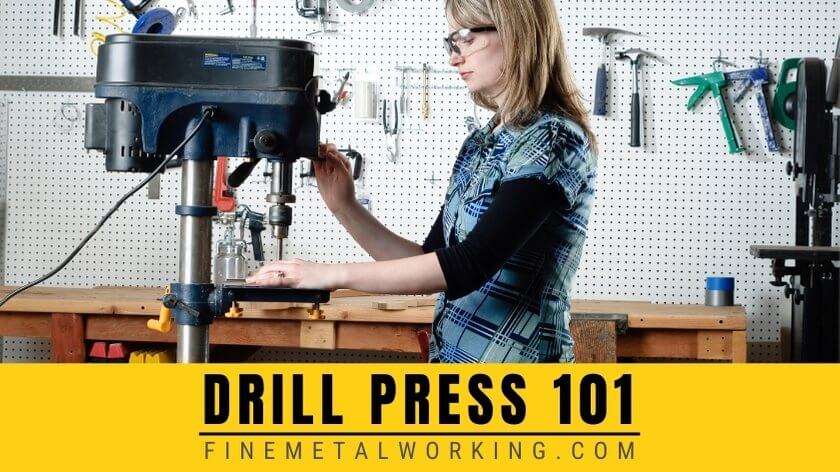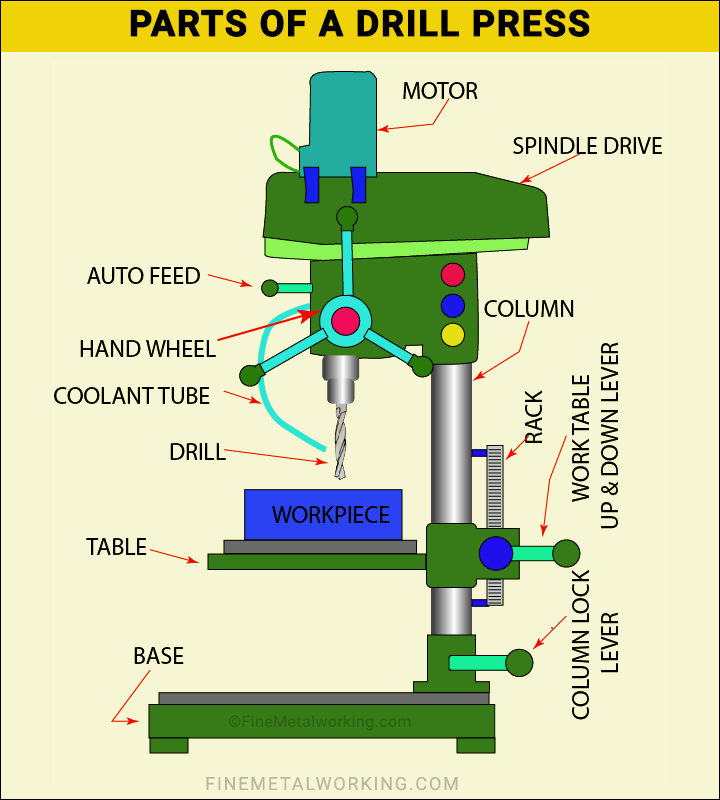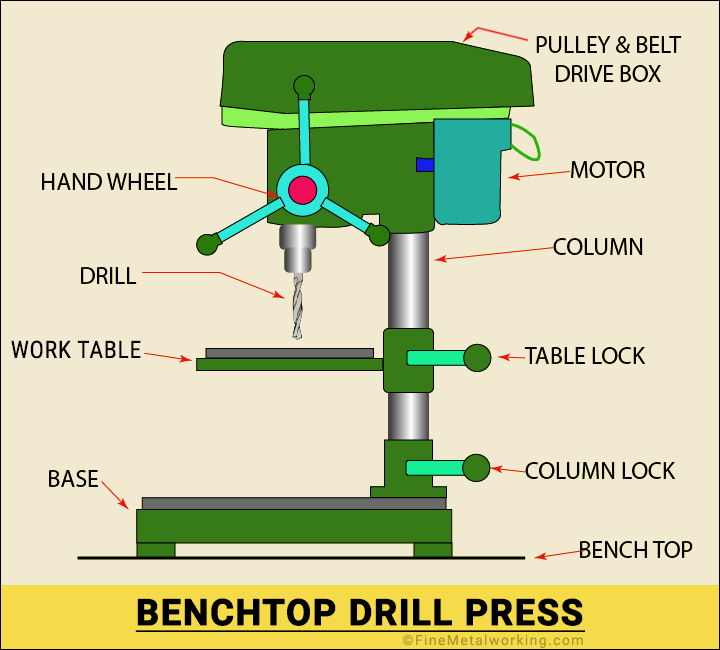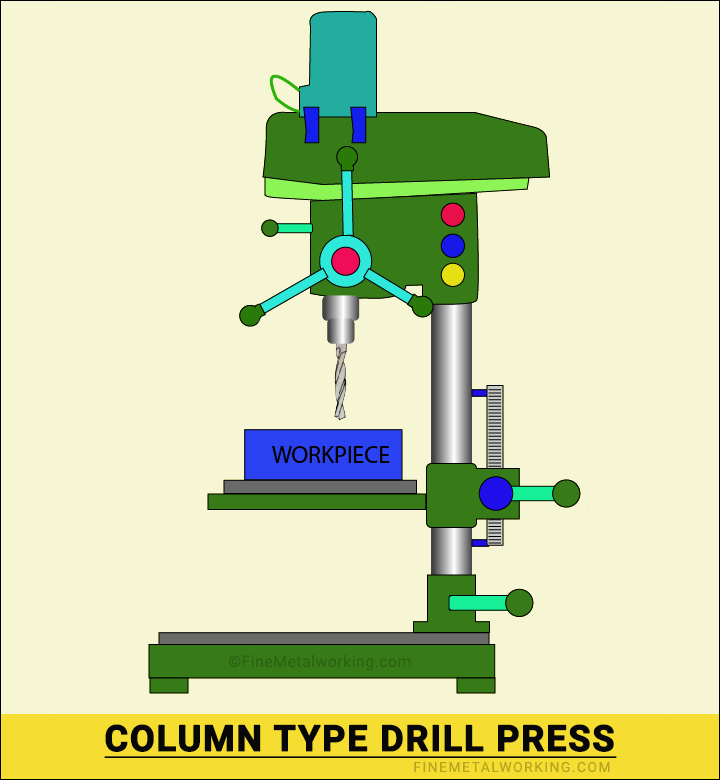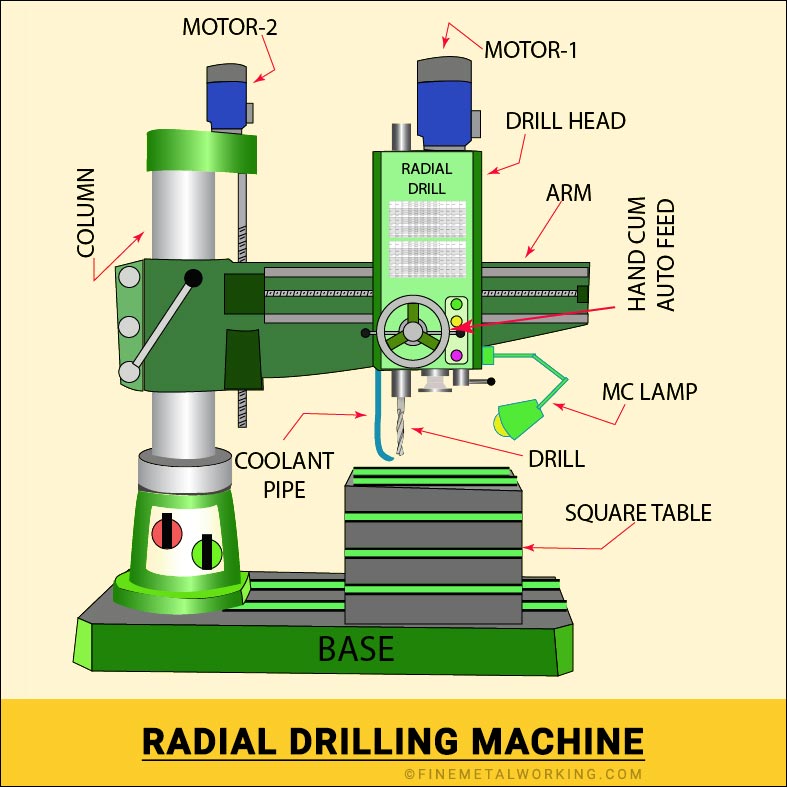The drill press basics, how it works, different types, uses, and the safety precautions that you should follow.
You are all aware of the importance of a lathe machine in any workshop. You cannot imagine a workshop without a lathe and this applies to the drilling machine also. It is a basic machine which can be seen in any workshop big or small.
What is a Drill Press?
A Drill press or a drilling machine is required when you want to make a hole on any metallic or nonmetallic workpiece. The end cutting tool used for drilling is called a drill.
Parts of Drill Press
The drilling machine normally consists of a pillar vertically mounted on a base, a drill head with motor, drive, and spindle, and a table for mounting the workpiece.
You can use a drill chuck, quick-change sleeve, etc. mounted on the spindle, to hold the drill; depending on the type of drilling machine you can change the spindle speed by manual belt change or gear drive.
You can make a hole by pressing the rotating drill onto the workpiece. The feed of the drill can be manual or by power.
Drilling Operations
What can you do with a drill press? You can use a drilling machine to do the following operations:
- Center drilling.
- Drilling.
- Step drilling.
- Counter boring
- Countersink.
- Reaming.
- Tapping
If the machine is sturdy, you can enlarge a drilled hole by boring and can even do small milling work on a drill press.
Coolant System
Like the other machines, the drilling machine also needs a cooling system to cool the cutting area. Normally all drilling machines will have a cooling system consisting of a coolant tank, coolant pump, connecting hose, and a filter to separate the chips.
In small machines that do not have a cooling system, you need to spray a cooling oil manually to the cutting area.
What is the purpose of a drilling machine?
You can do the drilling operation on any machine which has provision for rotating the work-piece or the tool, like a lathe or milling machine. However, a dedicated machine for drilling will make the work faster and accurate.
You can drill a workpiece in the following steps: center marking → center punch → center drill → drilling to the required size in one or more steps.
For doing tapping or reaming, you need to predrill a hole of the recommended size.
Types of Drilling Machines
1. Bench Drill Press
The Benchtop Drill Press is a simple drilling machine that you can mount on a work-bench in your hobby workshop; this consists of a vertical pillar mounted on the base and a table and drill head (with belt pulley drive) mounted on the pillar.
Fasten the base to the workbench. Move the work table up or down on the pillar and clamp at the desired position. Clamp the workpiece on the table and hold the drill in the drill chuck.
Normally, you need to manually feed the drill by moving the spindle/quill up/down, to make the hole. You can change the drill spindle speed by changing the belt position on the stepped pulley.
Uses:
Ideal for a hobbyist or a small workshop for doing the drilling, counter drilling, countersink, tapping, reaming on wood, plastic, and metal workpieces. The machine may have a chucking capacity up to 13 mm and a spindle taper B16.
2. Pillar or Column Drilling Machine
This is similar to your Benchtop drilling machine, however, bigger in size, higher in capacity (bigger size drill), and with power-feed. This will produce more accurate holes with a better finish and higher tool life than the benchtop machine. The pillar drilling machine is built for relatively heavier work and with power feeds.
This machine is floor mounted or table-mounted and you can move the work-table up and down the column (with rack and pinion) and lock at the desired position.
The base and the work-table of your machine have T-slots for clamping the workpiece. The machine capacity can be (i) drilling capacity in Mild steel/Cast Iron is 25/32 mm (ii) M20 tapping (iii) Spindle taper MT3 and (iv) Motor 1 HP.
Use:
Ideal for a small workshop for doing the drilling, counter drilling, countersink, boring, counter-bore, tapping, reaming on wood, plastic, and metal workpieces.
3. Horizontal Drill Press
You may find a Horizontal Drill Press in a woodworking workshop; the face of the wooden log to be drilled is mounted on the machine table facing a rotating chuck with a drill and the drilling is done by feeding the drill onto the wooden log using a foot lever.
Horizontal Drill Press is not popular in a regular workshop; if at all you need to drill a hole in the horizontal axis, you can always use a lathe or a horizontal milling machine.
However, horizontal drilling is followed in Hi-tech Deep Hole Drilling Machine. You can term a drilled hole as ‘deep’ when the depth of the hole is large when compared to its diameter.
You can find Hi-tech Deep Hole Drilling Machine with a capacity for drilling holes of diameter 30 to 200 mm and depth up to 6000 mm.
You can find many applications for Deep Hole Drilling Machine like equipment for the army, manufacturing of aircraft, oil exploration equipment, etc.
4. Radial Drill Press
Major parts of a Radial Drill Press are, a vertical column mounted on the base, an arm with a drill head mounted on the column.
The arm of the Radial Drilling Machine can swing around the column and can also move up or down on the column.
You can move the drill head to and fro across the arm manually or by using the power feed.
The quill/spindle of the Radial Drilling Machine can be moved up and down manually or by power.
The machine base has T-slots and you can directly mount heavy jobs on this or you can use a box table with T-slots for clamping the medium size workpiece. The box table may have the option of tilting to an angle for drilling angular holes.
The capacity of a typical Radial Drilling Machine can be drilling in Mild steel / Cast iron 50/60 mm, drilling depth 300 mm, and main motor 3.5 KW.
Uses: This machine is suitable for medium or big industries for drilling, counter drilling, boring, counter-boring, tapping, reaming, etc. You can do medium to heavy jobs and the feature of the arm (mounted with drill head) moving around the column makes it very flexible. You can see more than one Radial Drills in many industries.
5. Gang Drilling Machine
A Gang drilling machine will have two or more drilling heads mounted on the same table. You can run all the drilling heads simultaneously or in a sequence for doing multiple drilling operations on the same workpiece.
The spindles may have hand-feed or power feed and you can independently set each spindle for different operation, feed, and depth.
You can go for a Gang Drill with power fed for more accurate and faster work.
Use: Gang drilling will be handy when you have a batch of the same component where drilling, tapping, reaming need to be done and you can plan to do this in a continuous sequence on a gang drill.
6. Multi-spindle Drilling Machine
In the Multi-spindle Drilling Machine, you will notice that there are more than two spindles (can be 4, 5, or more depending on the design) driven by one motor using a drive mechanism, and the spindle may have universal ball joints for flexibility.
Use: By using this machine along with a jig plate for guiding the spindles, you can drill several holes of different sizes on the workpiece simultaneously.
7. Turret-head Drilling Machine
You may find this type of machine in an old workshop. This vertical turret-head drilling machine is similar to a regular drilling machine, however, you will have a six- side turret head instead of the drill head. You can index the turret head to bring any of the six spindles to the drilling position.
There is one spindle on each of the six sides of the turret and you can do six different drilling or tapping or reaming operations on the same workpiece in a sequence.
Use: You can do complete drilling machine operations on the workpiece in one setup.
8. Mill Drill Machine
The Mill Drill Machine is a simple low-cost Vertical Milling machine that can be used for milling and drilling machine operations and is suitable for a small workshop.
The construction of the Mill Drill Machine is the same as a Vertical Milling Machine, viz. base, column, a table with T-slots (for mounting the workpiece) which can move in X and Y axes and a mill-cum-drill head with up/down movement in the Z-axis.
Depending on the price, your Mill Drill Machine may have manual or power movement for table and mill-cum-drill head movement. Normally, you can do drilling up to 30 mm and use end mills up to 25 mm in size. You can also do other operations like a counter drill, countersink, boring, tapping, and reaming.
Some high-end Mill-Drill machines may have a ram for mounting the mill-cum-drill head and an attachment for Horizontal Milling.
Uses: Ideal for a small workshop for doing all the milling and drilling operations on a medium-size workpiece.
9. Magnetic Drill Press
The Magnetic Drill Press is very compact and is made for portability. It has a drilling capacity of 1.5ʺ diameter and 2ʺ depth.
A Magnetic Drill Press has a drill head with manual feed and is mounted on a very strong electromagnet base.
Using a Magnetic Drill Press is very easy; take it to the work (job) which is to be drilled (a large thick plate or a flat or a beam), adjust for the drilling position, connect to the power source and clamp it to the work by switching on the electromagnet.
Complete the drilling, switch off the electromagnet, clean the chips, and clamp for the next drill.
The Magnetic Drill is very flexible, camp it sideways or upside down or straight and you are ready to go. There is a provision to chain the Magnetic Drill to the work so that it will not fall down in the event of magnetic base failure. This is essential if you are working at height. You have a provision to lubricate the drill for cutting.
The machine uses twist drills up to 12 mm diameter and core drill bits for drills above 12 mm.
Use: A Magnetic Drill Press can be used in construction work, site work, and heavy fabrication jobs. Actually, you can use a Magnetic Drill Press wherever you want to drill metals that are magnetic.
10. CNC Drill
A CNC Drill in its simplest form will have a table with movement in X and Y axes and a drilling head with up and down movement in the Z-axis. Alternately, the movement in X, Y, and Z axes may be with the drill head.
The movement in X, Y, and Z axes can be programmed and fed into the machine CNC system for drilling of the holes at the desired location on the workpiece.
The tool change can be manual or there can be a tool magazine and tool changer.
Your CNC Drill may have more than one drill head. Also, the CNC Drill can have a Mill-Cum-Drill head.
Application: In many industries, you need plates with several drilled holes with good finish and location accuracy, and CNC Drill is best suited for this.
Similarly, CNC Drill can be used for drilling of holes on a large diameter flange.
A CNC Drill can do simple milling and drilling operations in the same setup.
Hand Drills (corded and cordless)
A cordless drill is the most commonly used power tool. The hand drill machine or simply Drill does not fall under drill press category. However, this will not be complete without mentioning it.
Many times, you need to drill a hole on a job being fabricated, or in construction work, or simply to drive a nail on the wall of your living room. In all these cases, you cannot move the job to the drilling machine, so, instead, move the Hand Drilling Machine to the place where drilling is required.
Your Hand Drilling Machine may have a drilling capacity of up to 10 mm in mild steel and comes with a key-less chuck.
The Hand Drilling Machine can be corded (you need to plug into an electric source) or cordless (works with a chargeable lithium battery).
Other than the source of power (battery or from the mains), a corded drill or a cordless drill works in the same way.
Drill a straight hole with a cordless drill is not always easy. You need a pair of steady hands and the skill to do a good job using a Hand Drill.
Use: You can take your Hand Drill wherever drilling needs to be done, viz. at home, at the site, or to drill a hole on a fabricated work or to repair an automobile.
Drill Press Safety
What are the safety rules for the drill press?
Every machine small or big needs to be operated safely and your drilling machine is no exception. The following are the safety rules you must follow when you work on a drilling machine.
- Do not wear loose clothes. Wearing half-arm shirts properly tucked in with a belt is the best. Wear shoes.
- Wait for the machine to stop, before you do any adjustments.
- Remove all loose tools from the drilling table and take out chuck keys or the wrench before you start drilling.
- Always use the brush to remove the chips.
- Wear safety goggles to protect your eyes from the flying chips.
- Place the drilling guard in place before you start drilling.
- Ensure the workpiece is properly clamped.
Should you wear gloves when using a Drill Press?
Yes, you can wear it, it will improve the level of safety.
Conclusion
The Drill Press, like a Lathe, is an important machine in any workshop, small or big. You cannot think of a workshop without a drilling machine.

